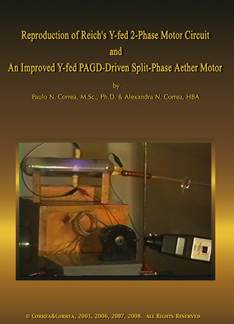![Akronos logo]](/images/akronos_wheel.jpg)
|
Akronos Publishing Concord, ON, Canada www.aetherometry.com |
![Akronos logo]](/images/akronos_wheel.jpg)
|
Akronos Publishing Concord, ON, Canada www.aetherometry.com |

The rediscovery of the ORgone motor:
(2) Reproduction of Reich's Y-fed OR Motor Circuit and
(3) An improved Y-fed PAGD-driven Aether Motor
by Correa, Paulo N. & Correa, Alexandra N.
Published in July 2006. 62 pages.
Experimental Aetherometry, Vol. 3
Monograph AS2-19
Price: US $35
Chapter 2 of the book The (Re-)Discovery of the Orgone Motor
|
ABSTRACT
In the present communication, the second in Volume 3 of Experimental Aetherometry, the Correas reconstruct the 2-phase motor arrangement employed by W. Reich to drive his unipolar Orgone Motor. In the process, the authors reveal the articulation of nearly all the fundamental elements which Reich sought to keep secret for fifty years (until 2007): - the Tesla method of transmission;The authors begin their investigation by employing a modified thyratron pulse amplifier to drive a split-phase motor, as the thyratron is triggered by plasma pulses in either the Transitional Region Discharge (TRD) or the Abnormal Glow Discharge (AGD) region - without any use of an HV DC supply, that is, by replacing the latter with a Function Y receiver that employs a full-wave divider. And they then proceed to what they believe is a reconstruction of Reich's Orgone Motor, by elimination of unnecessary transmission steps in the receiver circuitry, until the 2-phase arrangement emerges. Subsequently, the Correas carry out an experimental comparison of this 2-phase Aether Motor circuit to their own split-phase PAGD inverter-motor circuit, with the latter coupled to the Function Y circuitry but working without any input of AC electricity into any of the phases. The results show that their split-phase arrangement performs substantially better than does Reich's 2-phase arrangement. However, neither circuit, by itself, is capable of effectuating a coupling to the massfree electric energy output from a Tesla coil. Solution of this problem is provided in a subsequent communication, building upon what has been learnt here. |